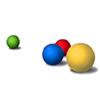Creating an RSS Feed
 RSS is an acronym for Really Simple Syndication and its a popular web feed mechanism for presenting the contents of your site to the Internet. RSS-aware programs from around the web will look at your website and perhaps use your RSS to display information and links from your website to their users. RSS is most popular with bloggers and is usually integrated automatically into their software and presentation. With my website its not so easy because jerryodom.com is a text based html site with no database for storing and organizing the data. The pages are simply here and presented for my visitors but being that I am a computer programmer I was quickly able to set-up an RSS feed generator for my website.
RSS is an acronym for Really Simple Syndication and its a popular web feed mechanism for presenting the contents of your site to the Internet. RSS-aware programs from around the web will look at your website and perhaps use your RSS to display information and links from your website to their users. RSS is most popular with bloggers and is usually integrated automatically into their software and presentation. With my website its not so easy because jerryodom.com is a text based html site with no database for storing and organizing the data. The pages are simply here and presented for my visitors but being that I am a computer programmer I was quickly able to set-up an RSS feed generator for my website.RSS Feed Generator = Simple. Site Organization = Not. In order for me to organize my site so as to present different RSS feeds for the sections and to supply accurate information I had to do quite a bit of manual house keeping. My website is an on a whim product. When I feel like posting I simply create a new page and sometimes I make mistakes.(no title, description, screwy navigation.) So I wrote some quick perl to verify all of my available pages were going to be able to be added to an RSS feed. I was suprised at how some of my pages lacked basic elements that I know should always be a part of a web page if you want search engines and therefore people to find them. So in setting up to program my RSS feed I improved the quality of my website. Winning project already. Creating a RSS Feed Generator This was a fairly easy thing to do using the PERL programming language. I simply wrote a parser for my html pages to pull apart the vital information and present them in the common RSS schema as defined in the RSS 2.0 Specification. Within a matter of hours I was logging requests from rss feed readers out looking around the Internet for new information. |
 The reason I took the time to develop a RSS feed for my website was actually several. First off I like playing with specifications to technologies and seeing what they can do to improve things. Second RSS is the way news travels around the Internet and I want to present my pages and my thoughts to as many people as will look at them. RSS is an simple way to get your writing out there with no hidden tricks or tactics such as are involved in search engine optimization. If the presentation of an RSS feed helps search companies such as Google or Yahoo find the legitimate information out there presented by small sites like mine through all the noise on the internet then its worth the time. Third reason quite simply is that I got to publish my website's contents to my personalized Google homepage and thats fun for me.(turbo nerd)
The reason I took the time to develop a RSS feed for my website was actually several. First off I like playing with specifications to technologies and seeing what they can do to improve things. Second RSS is the way news travels around the Internet and I want to present my pages and my thoughts to as many people as will look at them. RSS is an simple way to get your writing out there with no hidden tricks or tactics such as are involved in search engine optimization. If the presentation of an RSS feed helps search companies such as Google or Yahoo find the legitimate information out there presented by small sites like mine through all the noise on the internet then its worth the time. Third reason quite simply is that I got to publish my website's contents to my personalized Google homepage and thats fun for me.(turbo nerd)Well thats all for now. I know, I know, you're all running off to add rss feeds to your websites. Take care,
Jerry W Odom Jr March 7, 2006
RSS Feed Information(later added)
- Feed Validator - A fellow lsu alumni wrote me and told me I needed to validate my feed. Very useful tool.
